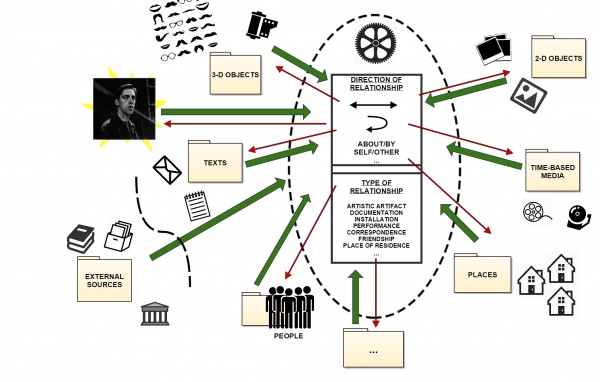About the Wojnarowicz Challenge
Researchers involved in the development of this resource were challenged by the nature of David Wojnarowicz’ life and art. His works often do not fit into typical art historical classifications of medium and style, nor do they fit into standard archival descriptions. As depicted in the diagram on the left designed by project researcher Francisco Chaparro, there is a complex web of relationships between David Wojnarowicz, his artworks, people he knew and worked with, places associated with him and his art, texts related to his work, and external resources that may be helpful to users of this knowledge base. This recognition drove us away from designing a hierarchical database towards a wiki platform that affords multiple linkages within the resource, promoting a deeper understanding of these relationships.
To illustrate these complex relationships, Wojnarowicz used the same images, objects and references in multiple contexts, allowing them to develop multiple meanings and functions. One example of an object that was presented in multiple contexts is a life-sized shark that he covered with maps and exhibited as a component of his Burning Child installation at the Gracie Mansion Gallery in 1984. The shark was also shown as a hanging sculpture apart from the installation in addition to appearing in photographs. It exists in his personal archive as both an independent artwork and an element of another artwork.
The Magic Box, depicted below on the right, is another example. It contains sixty-nine objects collected by Wojnarowicz, including plastic toys, jewelry, stones, feathers, seeds, and photographs. The Magic Box disrupts archival and art historical concepts of classification, provenance, context and description since specific functions of the box and its contents are not known. Yet the combination of objects holds complex symbolic and material values that shed light on Wojnarowicz’ life and art. Some objects were integrated into his art production and appear in his photographs and films; others were not. To make these links discoverable, should we identify the Magic Box and/or its components as artworks? Should we link them to multiple artworks on the wiki?
Another example of complex associations of Wojnarowicz’ objects that complicated our wiki design can be found in his stencils. They were used to produce graffiti, paintings, site-specific installations, and prints. Some of the stencils are associated with artworks at multiple locations over time, involving different people. In addition, many of the stencils are in poor condition, composed of ephemeral media, and in need of thorough research prior to conservation, exhibition, or publication. They are heavily soiled, torn, and evidence signs of use, all of which is considered integral to their history. Should conservators clean and repair them, or should the soiling and signs of deterioration be left to witness their history of use? How should we represent multiple viewpoints on the wiki?
One more example can be found in the Super 8 film fragments in the Downtown Collection of the Fales Library at New York University Fales. Some were spliced together in various combinations to make multiple films, as in the four versions of the “Mexico” films analyzed by project researcher Regina Harsanyi. Some of these fragments were never used, although Wojnarowicz intended to use them as evidenced by the storyboards in his notebooks. Various people were involved with the films, sometimes as actors, co-authors, producers, directors, camera operators, and editors. Often people played multiple roles, including as artists who featured Wojnarowicz in their own films or who were associated with his other works and exhibitions.
In addition to the complications of classifications, meanings, and associations, many of Wojnarowicz’ works, particularly his films and videos, were not completed during his life. Exhibiting an incomplete or posthumously assembled work has the problematic potential of misrepresenting his original intent. The current attention Wojnarowicz receives and the controversies surrounding the posthumous assemblage of his moving image and audio fragments make this research critical to scholars and professionals in the art world. Issues of appropriate conservation and exhibition practices, in addition to questions of authorship, authenticity, and artwork integrity that arise from Wojnarowicz’ work are relevant to many contemporary artists who employ ephemeral media, use conceptual strategies and create media installations.
In developing this resource, project researchers needed to distinguish fact from fiction, or at least to recognize a certain fluidity, since Wojnarowicz’ writings, and those of others, and our interviews all contain conflicting statements. For example, he wrote in his notebooks about real and fictional characters that need to be distinguished in the database. He and others gave contradictory details of his life, his art, and past exhibitions. We provide citations for our sources, and accept contradictions where they exist. In the future we plan to host multiple timelines of his life that illustrate contradictions in accounts of his biography to researchers. We invite researchers to contact us if they find errors, and encourage contributions from users of this resource. Please contact us at <Gatekeeper email to be linked>.


